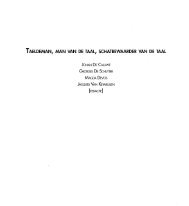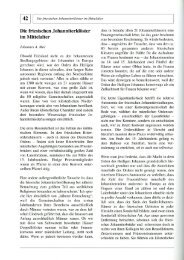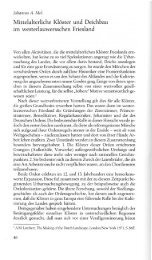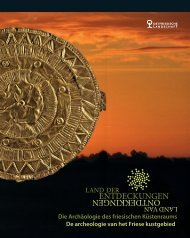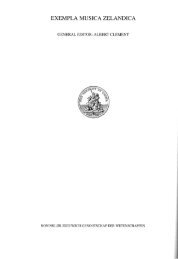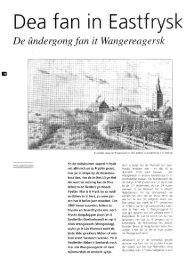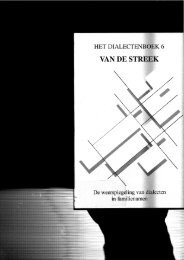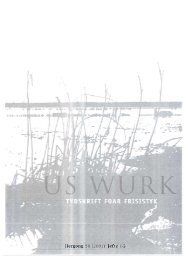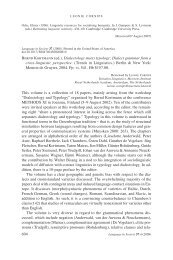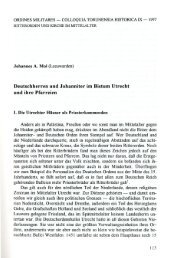Locating Life Stories
Locating Life Stories
Locating Life Stories
Create successful ePaper yourself
Turn your PDF publications into a flip-book with our unique Google optimized e-Paper software.
<strong>Locating</strong> <strong>Life</strong> <strong>Stories</strong>
i o g r a p h y m o n o g r a p h s<br />
The Center for Biographical Research of the University of Hawai‘i at Mänoa is dedicated<br />
to the interdisciplinary and multicultural study of life writing through teaching, publication,<br />
and outreach activities.<br />
In addition to Biography: An Interdisciplinary Quarterly, published since 1978, the Center<br />
sponsors the Biography Monograph series; a chronological list of previous monographs<br />
follows.<br />
Anthony Friedson, ed. New Directions in Biography (1981).<br />
Gloria Fromm, ed. Essaying Biography: A Celebration for Leon Edel (1986).<br />
Frank Novak, Jr. The Autobiographical Writings of Lewis Mumford: A Study in Literary<br />
Audacity (1988).<br />
Mari Matsuda, ed. Called from Within: Early Women Lawyers of Hawaii (1992).<br />
Alice M. Beechert and Edward D. Beechert, eds. John Reinecke: The Autobiography<br />
of a Gentle Activist (1993).<br />
Donald J. Winslow. <strong>Life</strong>-Writing: A Glossary of Terms in Biography<br />
(2nd ed., 1995).<br />
Koji Ariyoshi. From Kona to Yenan: The Political Memoirs of Koji Ariyoshi.<br />
Ed. Alice M. Beechert and Edward D. Beechert (2000).<br />
Leon Edel. The Visitable Past: A Wartime Memoir (2000).<br />
Ruth Nadelhaft, with Victoria Bonebakker, eds. Imagine What It’s Like:<br />
A Literature and Medicine Anthology (2008).<br />
Kodama-Nishimoto, Michi, Warren S. Nishimoto, and Cynthia A. Oshiro, eds. Talking<br />
Hawai‘i’s Story: Oral Histories of an Island People. (2009).<br />
Lejeune, Philippe. On Diary. Ed. Jeremy D. Popkin and Julie Rak. Trans. Katherine<br />
Durnin (2009).<br />
Osorio, Jonathan Kay Kamakawiwo‘ole, and Craig Howes, eds. The Value of Hawai‘i:<br />
Knowing the Past, Shaping the Future (2010).<br />
For further information about the Center or its publications, contact the Center for Biographical<br />
Research, University of Hawai‘i at Mänoa, Honolulu, Hawai‘i 96822 USA;<br />
telephone/fax: 808-956-3774; biograph@hawaii.edu; www.hawaii.edu/biograph.
<strong>Locating</strong> <strong>Life</strong> <strong>Stories</strong>:<br />
Beyond East-West Binaries in<br />
(Auto)Biographical Studies<br />
edited by<br />
maureen Perkins<br />
a Biography Monograph<br />
published for the biographical research center<br />
by the university of hawai‘i press<br />
2012
© Copyright / CIP page<br />
copyright to Bi o g r a p h i c a l Re s e a r c h Ce n t e r<br />
t e x t p r o v i d e d b y l i b r a r y o f c o n g r e s s/<br />
university o f h a w a i‘i p r e s s
c o n t e n t s<br />
Maureen Perkins<br />
Never the Twain: <strong>Life</strong> Writing’s Geographical Contexts 1<br />
Philip Holden<br />
Refusing the Cultural Turn: Amir Muhammad’s Politics of Surfaces 15<br />
Kenneth George<br />
<strong>Life</strong> Writing and the Making of Companionable Objects:<br />
Reflections on Sunaryo’s Titik Nadir 35<br />
Mathilda Slabbert<br />
“These people are my people, these places are my places”: Cultural<br />
Hybridity and Identity in South African Artist David Kramer’s Oeuvre 55<br />
Tony Simoes da Silva<br />
Under New Management: Whiteness in Post-Apartheid<br />
South African <strong>Life</strong> Writing 83<br />
Craig Howes<br />
The Fictobiographical Pact 97<br />
Bryan Kamaoli Kuwada<br />
Hidden Heroes: Cultural Interaction and Nationalism<br />
in Nineteenth and Early Twentieth Century Hawaiian Biographies 115<br />
Maria Faini<br />
Ethics, Oral History, and Interpreters in the Iraq War 139<br />
Gerry van Klinken<br />
“Don’t write this”: Researching Provincial Biographies in Indonesia 169<br />
Peter Read<br />
Biography in the Court Room? Far from a Final Judgment 193<br />
David T. Hill<br />
Writing Lives in Exile: Autobiographies of the Indonesian Left Abroad 215<br />
Kirin Narayan<br />
Local Boons: The Many Lives of Family <strong>Stories</strong> 239<br />
Pei-yi Wu<br />
The Jiwen of Shen Cheng for his Daughter Azhen 259<br />
Co n t r i b u t o r s 263
“d o n’t w r i t e t h i s”: r e s e a r c h i n g<br />
p r o v i n c i a l b i o g r a p h i e s in i n d o n e s i a<br />
g e r r y v a n k l i n k e n<br />
In the dim coolness of his lounge room he had talked animatedly about many<br />
interesting topics in Kupang’s modern history—Chinese shops in the 1950s,<br />
schools, newspapers, social rankings in town, civil servants, the Japanese occupation.<br />
As I stood up to leave and put away my notebook, the conversation<br />
suddenly turned to February and March 1966, the months when the military<br />
suppression of the Indonesian Communist Party (Partai Komunis Indonesia,<br />
PKI) reached its height all over Indonesia. “Don’t write this,” he said. Then<br />
he told me: “I was forced to witness five mass executions. PKI members and<br />
activists were taken out of town at night. Each time, tens of people were shot,<br />
each time with the proclamation: ‘Now you can see what happens to PKIers.’<br />
It was horrifying. I will never forget it.” It was one of my first interviews<br />
in Kupang, and already I had a dilemma. How could I write history and not<br />
“write this”?<br />
Biographers frequently perceive their task in a different light than do the<br />
gatekeepers of biographical sources upon which they must rely. The gatekeeper<br />
has in mind a pleasing portrait, the biographer looks for possibly unflattering<br />
social and psychological processes. One feels responsibility to the<br />
subject, the other considers mainly the subject’s responsibility to the world.<br />
The gap becomes a dilemma if the gatekeeper holds nearly all the available information<br />
on the subject, which is often the case in the Indonesian provinces<br />
of the 1950s. The dilemma grows if the gatekeeper invests this knowledge<br />
with the honor of family, town, class, or perhaps even nation, and if the biographer<br />
comes from the old colonial country. Happy are those who reach an<br />
agreement to satisfy scholarship. In my case, although my informants knew<br />
the outline of my project, there was no explicit agreement about how their information<br />
would be used. They may be surprised by what they finally read.<br />
Where are the limits of my ethical responsibilities to informants? I have<br />
tried to adhere to the following four principles:
170 <strong>Locating</strong> <strong>Life</strong> <strong>Stories</strong><br />
(a) information given in confidence must never be reported if it can be traced to a<br />
particular informant;<br />
(b) if the same information is also available in a public document, it can be quoted<br />
from there, even if I first learned it confidentially;<br />
(c) if it is possible to anonymize information given in confidence, it can be included<br />
if it illustrates a broader trend already identified from publicly identifiable sources;<br />
(d) beyond these ethical limits, my primary responsibility is to a broad readership;<br />
if my informants do not share that responsibility, they cannot have the last word,<br />
even if they have become friends.<br />
I applied these principles in the first paragraph above. Mass killings of alleged<br />
PKI members or sympathizers in Kupang in the mid-1960s have been<br />
documented elsewhere. The horror of being forced to watch recurred in other<br />
interviews I held in Kupang. I have not identified the person who told me his<br />
story. However, I realize this does not entirely solve the problem of having<br />
written something I was told not to write, and we will return to this question<br />
at the end.<br />
In the northern summers of 2009 and 2010 I spent a total of two months<br />
in and around Kupang, capital of the impoverished eastern Indonesian province<br />
of East Nusa Tenggara (Nusa Tenggara Timur, NTT). I wanted to learn<br />
about the rise of an indigenous provincial middle class outside the central<br />
island of Java. This was the historical part of a collaborative ethnographic<br />
project on middle classes in middle-sized towns—a social zone that we, partly<br />
thinking of Middle America (Lynd and Lynd), called Middle Indonesia<br />
(Klinken). Unlike the “commanding heights” of politics in the metropolis, or<br />
Map reproduced by courtesy of the KITLV (Koninklijk Instituut voor Taal-, Land- en Volkenkunde/Royal<br />
Netherlands Institute of Southeast Asian and Caribbean Studies).
Van Klinken, Researching Provincial Biographies in Indonesia 171<br />
the “grassroots” in the village, the provincial town mediates between the center<br />
and the countryside, between ruling elite and poor majority, between state<br />
and society. These complex mediation processes hold the country together, so<br />
it is surprising that they have been so little studied.<br />
The bureaucratic town of Kupang is one of five case study sites in Middle<br />
Indonesia. 1 If the birth of this new middle class took place in the 1930s,<br />
when Kupang was a sleepy town of 7,000, and it reached adulthood at the<br />
height of the developmentalist New Order in the 1980s with a population<br />
of 91,000 (Leirissa, Kuntowidjojo and Kartadarmadja 53), then its formative<br />
childhood years were the 1950s and ’60s. I decided to focus on the lives of<br />
several individuals who, to my social science mind, more or less represented<br />
the most important social struggles in Kupang in those decades. I wanted to<br />
keep in mind two broad perspectives. One was class, which seemed to me to<br />
be the main driver of the remarkably intense political struggles of this period.<br />
2 The other was a sense of location, of geography, or of what Daniels and<br />
Nash called “lifespace” (456). I did not pretend that such large themes could<br />
be studied definitively through the lives of just a few individuals, but those<br />
lives could certainly serve as heuristic guides.<br />
My preliminary reading, which I am elaborating elsewhere, led me to<br />
think of two struggles that were won, and two that were lost. Similar struggles<br />
were won and lost in many other provincial towns at about this time<br />
(Sutherland). They were the rise of Indonesian republicans (mostly commoner<br />
bureaucrats), the decline of traditional aristocrats, the rise and subsequent<br />
decimation of left-wing organizers, and (linked to the latter) the rise of the<br />
military. The contexts for these struggles were multidimensional, but can be<br />
sketched in a few phrases. They include urbanization, which quickened after<br />
World War II in a predominantly rural landscape; the absence of a national<br />
revolution in the eastern archipelago, which unlike the central island of Java,<br />
remained under colonial control until 1950; the subsequent elitism of government<br />
in this area, with its preference for technocratic rather than democratic<br />
modernization; and oil-powered transportation that steadily reduced<br />
the distance to the capital, and hence facilitated political centralization. These<br />
structural transformations intensified cultural ones. Movies and magazines<br />
stimulated new lifestyles, religion became more modern and more prominent,<br />
new gender roles emerged, easier mobility and long-distance communications<br />
altered language usage. None of these changes are as yet well understood<br />
by historians of this area.<br />
Who would become my subjects? History belongs to the victors, so identifying<br />
representatives of the rising forces was fairly easy. In 2006, IH Doko<br />
(1913–1985) was proclaimed the province’s second National Hero (pahlawan<br />
nasional ). The perfect republican. Moreover, this educator and politician
172 <strong>Locating</strong> <strong>Life</strong> <strong>Stories</strong><br />
wrote prolifically, also about himself. As for the military, who so thoroughly<br />
dominated government throughout the New Order (1966–1998), no one<br />
could represent them as well as the flamboyant Elyas Tari (1926–1978), provincial<br />
governor for twelve years from 1966. The losers were more difficult<br />
to bring to light, as they had largely disappeared from the public record. I<br />
chose Alfons Nisnoni (1907–1987), the last king of Kupang, as my declining<br />
aristocrat. Michael Marcus (1906–1966), a Kupang politician who from<br />
1960 headed up a successful district branch of the communist-affiliated Indonesian<br />
Farmers Union (Barisan Tani Indonesia, BTI), became my representative<br />
leftist.<br />
Where could I learn more about these four individuals? None were nationally<br />
significant, so they are practically absent from standard history books<br />
and national Who’s Who collections such as Roeder’s. Indeed, little of national<br />
moment ever happened in this town. Perusing the national daily Merdeka<br />
from 1946–1959, my research assistant Basilius Triharyanto found only a<br />
single reference to Kupang, namely when President Sukarno visited in May<br />
1954 (“Presiden”). Many locals share that blank feeling. Hearing about my<br />
interest, one Kupang student responded with a puzzled look: “Does Kupang<br />
have a history?” This ordinariness makes the town an excellent case study site<br />
for Middle Indonesia.<br />
Nevertheless, Kupang is a literate society, and it has plenty of written local<br />
history. The provincial office of the Education Department has produced<br />
a stack of history textbooks for use in NTT schools. These are available at the<br />
downtown state library, which I always found full of students writing their<br />
assignments. Prominent figures such as IH Doko wrote memoirs late in life.<br />
Many of the city’s streets are graced with the names of local luminaries like<br />
Tom Pello, ER Herewila, Herman Johannes, and of course El Tari and IH<br />
Doko. There are a startling number of statues. K. Passar, an enterprising journalist,<br />
compiled a 300-page biographical encyclopedia of NTT personalities<br />
with about 1,000 entries. Passar’s encyclopedia is by far the most comprehensive<br />
Who’s Who, but several other NTT collections also contain biographical<br />
sketches or interviews (Adam et al.; Leirissa, Kuntowidjojo and Kartadarmadja;<br />
Liliweri, Didoek and Kulas; Widiyatmika, Sejarah). In short, Kupang’s<br />
middle class loves writing and reading about its own prominents. However,<br />
this knowledge circulates in rather personalized ways. Passar’s extremely useful<br />
encyclopedia can only be bought at the author’s home in a dusty backstreet,<br />
after office hours, over tea. Memoirs, too, disappear off the shelves of the<br />
town’s only decent bookstore, Gramedia, within six months of publication.<br />
The reader is advised to visit the author at home to obtain a copy.<br />
Needless to say, my “social forces” and “political struggles” interest these<br />
local historians little if at all. Their template is the national hero, who resists
Van Klinken, Researching Provincial Biographies in Indonesia 173<br />
the colonial Dutch, brings Kupang into the Indonesian nation, and helps<br />
build religion and the economy. After noting in his preface the “colossal<br />
and monumental” scope of his magnum opus, Passar wrote that he and his<br />
committee chose as their subjects all those who “had spread the sweet aroma<br />
of the greatness, the nobility as well as the success and the esteem of Nusa<br />
Tenggara Timur as a part of Indonesia’s civilized future” (ii). In his foreword,<br />
Professor Alo Liliweri praised the compiler’s creativity, and only feared some<br />
readers might find cause to ask: “Is this person important, is this person a<br />
prominent, is this person a leader, did this person make a positive contribution,<br />
is this person a successful human being, etc.” (v).<br />
A massive bust of Doko stands in the vast grounds of the provincial Education<br />
Department, which he founded in 1959. It was raised by the thousands<br />
of teachers whose careers he made possible. His political achievements<br />
on behalf of the Republic are told in one of his own books (Nusa). As Governor<br />
El Tari wrote in a foreword, the book proved “that Nusa Tenggara<br />
Timur has never been absent in the struggle for national RIGHTS” (emphasis<br />
in the original)—a veiled rejection of the feeling in Jakarta that poor, peripheral,<br />
Christian NTT had only been dragged into the republic by forces<br />
beyond its passive, not to say backward, self. Doko belonged to a small group<br />
of Kupangers, most educated in Java, who rose to prominence under the<br />
Japanese (1942–45). Afterwards, Indonesian republicans in Java proclaimed<br />
an independent republic, but at first its writ ran only in parts of Java and Sumatra.<br />
The Dutch easily reasserted control outside Java. They appeased nationalist<br />
sentiment by creating a number of “states” within a federation that<br />
also included the Netherlands (the idea was inspired by French Indochina).<br />
Timor belonged to the most successful and most democratic of these federal<br />
states, the State of Eastern Indonesia (Negara Indonesia Timur, NIT), whose<br />
capital was at Makassar. Trained before the war as a schoolteacher, Doko belonged<br />
to a nationalist faction. His bright personality and speaking talents<br />
led him to be appointed first Assistant Minister for Information in 1947,<br />
then full Information Minister two years later, and finally Education Minister<br />
in 1950. Doko himself figures prominently in his well-told story of the<br />
decolonization of this part of the archipelago. His narrative is punctuated by<br />
mobilization rallies in Kupang whose frequency belied the town’s passivity,<br />
alternating with elite conferences in Sulawesi and Java. The nationalist cause<br />
travels with Doko, backwards and forwards between the center and the islands.<br />
Thanks to a multitude of such efforts by the young nation’s educated<br />
elite, republicanism had triumphed over colonialism even in the remotest<br />
islands by 1950. His version of history has since then become unassailable.<br />
It is retold with little variation in all the provincial history textbooks (e.g.<br />
Djeki et al.; Koehuan, Kotten, and Bunga; Soh and Indrayana; Widiyatmika,
174 <strong>Locating</strong> <strong>Life</strong> <strong>Stories</strong><br />
NIT Information Minister IH Doko visiting the Raja of Kupang, probably around 1949 (NIT Information<br />
Ministry photo; private collection, reproduced by courtesy of Mr. Leopold Nisnoni).<br />
Lintasan). Doko’s books also remain a major source for western-trained historians<br />
(Ardhana; Farram, “From”).<br />
If Kupang’s teachers are proud of their Doko statue, the town boasts no<br />
less than three of former NTT governor, Brigadier-General (posthumously<br />
promoted to Major-General) El Tari. All are in good repair. He is one of a<br />
gigantic threesome on a roundabout at the eastern end of El Tari Road. 3 Another<br />
one decorates the driveway into El Tari Airport outside Kupang. And<br />
he stands two meters tall in front of the Agriculture Department office, arm<br />
outstretched in a commanding posture, instructing the peasants to “plant,<br />
plant, plant, and plant again” (tanam, tanam, tanam, sekali lagi tanam) (Passar<br />
272). 4 (I discovered afterwards that this tree-planting scheme to combat<br />
soil erosion, lacking funding and land allocation, could never succeed; see<br />
Liliweri, Didoek and Kulas 112). His successor as governor, the soldier and<br />
medical doctor Ben Mboi, now retired but still energetic, frequently urges<br />
student audiences to become “young El Taris” (Mboi 84). The man’s paternalistic<br />
good humor and frequent tours to inspire the poor to better their lot<br />
are still held to be exemplary.<br />
Thus Kupang honors its emancipators. What did surprise me was that<br />
even these heroes are so little understood. The rather detailed entry on Doko<br />
in Passar’s encyclopedia is misfiled under his middle name “Huru,” so I did
Van Klinken, Researching Provincial Biographies in Indonesia 175<br />
not discover it till much later. It does not report his death date, twenty years<br />
before publication. To learn more, I had to go to the home of the Kupang historian<br />
who wrote the bio of him that accompanied the National Hero application.<br />
Indonesia now has 156 official national heroes, and the bureaucratic<br />
procedure that produces them is complex but well-oiled. 5 As often happens,<br />
Doko’s process was initiated and financed by his son. Paultje Doko is a retired<br />
banker in Jakarta. He asked the Kupang academic Munandjar Widiyatmika<br />
to do the research. Later he paid a well-known national author to write a fullscale<br />
biography, with the intention of distributing it free of charge at a special<br />
provincial ceremony (Manafe). The book was not in the Kupang bookshop;<br />
Paul Doko gave me a copy when I met him in his father’s house in Kupang.<br />
Until then I had relied on a biographical sketch in the newspaper clipping on<br />
Doko’s herohood from 2006 (Malehere and Krenak), and on a rather confusing<br />
little biography written years earlier by an Education Department staff<br />
member (Boenga et al.). Finding the latter again entailed a visit to the author,<br />
who still worked at the department, to borrow his last copy for photocopying.<br />
My visit was enlivened by<br />
half an hour’s banter with<br />
all the other office workers,<br />
for whom I was welcome<br />
relief from boredom in the<br />
stifling heat.<br />
For all he was the province’s<br />
most adulated governor,<br />
El Tari turned out to<br />
be even more difficult to<br />
pin down on paper than<br />
Doko. Orphaned as a child,<br />
he has no surviving relatives<br />
literate enough to ensure<br />
immortality by ordering<br />
a biography. Only one<br />
obscure source mentions a<br />
birth date: 18 April 1926<br />
(Nahak). The one apparently<br />
fact-laden paragraph<br />
in the long El Tari entry in<br />
Passar’s encyclopedia, containing<br />
a list of his military<br />
appointments from 1945<br />
until his death in 1978, is<br />
El Tari (painting at El Tari’s family home in Fontein, Kupang;<br />
artist unknown; photo by Gerry Van Klinken).
176 <strong>Locating</strong> <strong>Life</strong> <strong>Stories</strong><br />
unsourced and full of outdated military acronyms that the editor had not<br />
understood. I later discovered that the source for this paragraph was the official<br />
obituary distributed at his funeral (Setwilda). Unfortunately, this document,<br />
too, was marred by errors and omissions. Military acronyms common<br />
in 1978 were backdated anachronistically to the 1950s, or misspelled unrecognizably.<br />
Informal revolutionary militias of the late 1940s are presented<br />
as full-scale regiments, which are then puzzlingly absent when I go to crosscheck<br />
them in the national registers. Military campaigns in which he had<br />
taken part were omitted. I recovered them laboriously from the list of his<br />
medals (themselves in military shorthand) appended to the obituary.<br />
If this is how it is with victors, how much deeper is the ignorance surrounding<br />
losers? At least Alfons Nisnoni, the last raja of Kupang, has an entry<br />
in Passar’s encyclopedia. It details his civil service career, but not the role<br />
rajas played under Dutch colonialism to control the peasant population, nor<br />
the republican challenge that led to their decline in the 1950s. Michael Marcus,<br />
the communist BTI leader in Soë, 110 km from Kupang, does not occur<br />
in the encyclopedia at all, nor do most other leftists (an exception is the<br />
inimitable Christian Pandy of the 1920s). Aristocrats in decline, and activists<br />
championing losing causes, are clearly not “successful human beings.” For<br />
more information on both I had to resort to guerrilla tactics—fragments in<br />
older books, newspaper clippings, archives, and oral history.<br />
s o u r c e s<br />
This is when I learned what a historical wasteland the Indonesian provinces<br />
of the 1950s and ’60s are. It is easier to write about a medieval European<br />
town than Kupang in the 1950s. Up to 1942 the situation is not too bad.<br />
Kupang’s long colonial history can be deciphered from archives preserved in<br />
the Netherlands and Jakarta (Ardhana; Farram, “From”; Fox; Hägerdal). A<br />
small VOC (Dutch East India Company) garrison first settled at the Portuguese-built<br />
Kupang fort in the early seventeenth century. By the early nineteenth<br />
century, the township was a significant imperial outpost. It acquired<br />
municipal boundaries in 1886, and by the 1930s the town had no fewer<br />
than nine regular (if slim) newspapers, some mailed out to Kupangers scattered<br />
throughout the archipelago’s colonial civil service. Submarines and<br />
aircraft paused at Kupang on their way to Australia. World events punished<br />
Kupang harshly after 1942. Allied bombing during World War II left the<br />
town in ruins. The Chinese shops by the harbor, the imposing official home<br />
of the Resident, the societeit overlooking Fort Concordia where elite Dutch<br />
and the Europeanized aristocracy had played bridge and billiards—all were<br />
gone.
Van Klinken, Researching Provincial Biographies in Indonesia 177<br />
Fire, impoverishment, bureaucratic inertia, and especially repeated and violent<br />
regime change played havoc with historical records after 1942. Today<br />
there are only three towns outside Java that have a continuous newspaper record<br />
for the 1950s, and none have any for the crisis-ridden 1960s. 6 Just when<br />
Kupang had been rebuilt, increasingly shrill politics in Jakarta caused the economic<br />
and institutional fabric to fray around the country. Only four shortlived<br />
newspapers appeared in Kupang during the half-century between 1942<br />
and 1992, and of these only one, the wartime broadsheet Timoer-Sjoeho, survives<br />
in a Dutch library, where it is searchable online. 7 The colonial discipline<br />
that once required every provincial newspaper to submit an archival copy of<br />
each edition to the state secretariat apparently broke down after 1942. Politics<br />
have been more brutal than bombs. To my knowledge, no one in Kupang<br />
dared to keep their copies of the communist broadsheet Pelopor after the<br />
government banned it in October 1965. A photo in the post-1965 Catholic<br />
magazine Dian (published in Ende) shows how the new regime regarded the<br />
past. A man is burning communist papers, over the caption: “so they will<br />
not be read by those who don’t have the right” (“Warta”). Just before Pos<br />
Kupang finally restarted on a sound footing in 1992, NTT was one of only<br />
“ . . . so they will not be read by those who don’t have the right”: burning politically suspect<br />
papers, probably in Flores, sometime after the 1966 regime change (from the 24 Sept. 1976 edition<br />
of Dian magazine, p. 8; photographer unknown).
178 <strong>Locating</strong> <strong>Life</strong> <strong>Stories</strong><br />
six provinces (out of twenty-eight) without its own daily. The only regional<br />
news journal that occasionally covered Kupang in the 1950s was the Catholic<br />
fortnightly Bentara, published in Ende. Significant parts survive in Catholic<br />
libraries in Ende and Maumere.<br />
Disasters have also done their share of damage. The town’s archives, once<br />
containing material going back to VOC times, were lost when the temporary<br />
wooden building in which they were housed burned down in 1964. What<br />
was left was flooded, then apparently burned again in 1982. Today Kupang,<br />
in keeping with its regional status, has a state library and no less than three<br />
official archives—provincial, district, and municipal. They contain abundant<br />
government publications (“grey matter”) starting from the 1980s, but<br />
nothing from the 1950s and ’60s. Yet few of the generous staff resources at<br />
these institutions are devoted to recovering those years. A relaxed atmosphere<br />
of chatting and newspaper-reading prevails in them. One is directed by a<br />
former harbor official (punishment for corruption?) who claimed to “know<br />
nothing” as he had “only been here eighteen months.” Another only allows<br />
non-official visitors to peruse documents that have been personally approved<br />
in an interview with the busy director. A dedicated young archivist at another,<br />
and an enormously helpful librarian at the State Library, by their contrast<br />
with the norm, merely underscored the tremendous theft of public resources<br />
that occurs in most provincial government offices.<br />
Scarcity makes knowledge a valuable resource, and its gatekeepers all the<br />
more powerful. Beyond the flimsy official texts and the statues, knowledge<br />
of the past is not public property, but a private hobby for the town’s elite.<br />
Personal archives have a higher standing among those in the know than state<br />
collections. A visiting researcher soon learns that former governor Ben Mboi,<br />
for example, possesses the best library in town, although I also learned, after<br />
a good dinner at the table of this gigantic man that included imported red<br />
wine, that it does not cover my period. Leo Nisnoni, son of Alfons Nisnoni,<br />
a retired civil servant who now makes a modest living as a tennis coach, keeps<br />
a large and well-indexed collection in his bedroom. He will dig into this with<br />
unfailing generosity for anyone interested, producing photographs, clippings,<br />
books, and papers. But some personal collections too have suffered from fire.<br />
IH Doko’s considerable personal library had been preserved by his son Paultje,<br />
but the house burned down in 2002. The neighbor’s house burned down<br />
as well, containing a reportedly excellent photographic collection made by a<br />
Mr. Lobo. Some personal archives are still waiting to be re-discovered. My<br />
biggest find in Kupang was the personal library of El Tari—twenty-six meters<br />
of books and official reports, still sitting on their original shelves in his house<br />
three decades after his death. The house was occupied by two sons of a man<br />
whom El Tari (whose marriage was childless) had “adopted” as his younger
Van Klinken, Researching Provincial Biographies in Indonesia 179<br />
brother. Both are private security guards and seemed practically illiterate, but<br />
they were determined to preserve the library in memory of the great man. They<br />
had refused to surrender it to the State Library, as the law requires of its retiring<br />
top officials. El Tari’s Mercedes still stood in the garage, deliberately looking<br />
neglected so rivals in the family (which seemed seriously divided against<br />
itself) would not come to claim it. The good-natured men let me spend hours<br />
perusing the library. Beyond that, leads to several old people in and around<br />
Kupang said to possess enormous archives turned up little. “People borrow<br />
things and do not return them” was the usual stoic explanation.<br />
e s t a b l i s h m e n t<br />
After thus circulating around Kupang on my little rented motorcycle for some<br />
weeks, calling often on acquaintances who possessed books and memories, my<br />
next discovery was that I had passed from free-floating researcher to a friend<br />
of the town’s historical establishment. Every provincial town has such a loose<br />
network, just a handful of people, whose knowledge is widely recognized as<br />
authoritative. The privatized nature of the best archives makes them real intellectual<br />
gatekeepers. In Kupang in 2009 it certainly included Leo Nisnoni,<br />
Munandjar Widiyatmika, and Hendrik Ataupah, the latter a retired professor<br />
at Nusa Cendana University. They do not agree on everything, but lives lived<br />
as government advisers, speakers, and columnists have given them all a sense of<br />
decorum. I have not yet met a truly knowledgeable historical dissident in the<br />
provinces; the town would not tolerate them. When the rare foreign researcher<br />
comes to Kupang, these local historians feel a responsibility to be helpful but<br />
also to ensure that no dangerous impressions arise that might discredit the<br />
town. Every researcher is familiar with the generous but stifling host who offers<br />
to arrange all contacts. The answer is to diversify sources. Once it becomes<br />
clear that one has a broad range of contacts, pressure eases and respect grows.<br />
The history of Kupang for my period, such as it is, was written by this little<br />
establishment. Most of its members are survivors of (and in some measure collaborators<br />
with) the anti-communist purges of 1965–66. Beginning in 1966<br />
and lasting well into the 1970s, the rector of Nusa Cendana University, Mr<br />
Muhammad Syah (whose family came from West Sumatra) hosted a weekly<br />
gathering at his home open to all interested in the history of NTT. Alfons<br />
Nisnoni was there, so were Munandjar Widiyatmika as a young lecturer new<br />
to Kupang, the anthropologist Hendrik Ataupah, not long back from a Master’s<br />
in the US, the bookish retired civil servant JJ Detaq, two priests interested<br />
in physical anthropology and prehistory—Verschuren and Darius Ngawa—<br />
the young female historian Mia Patty Noach just back from studies in Central<br />
Java, and two people about whom I know nothing more—I Toto and
180 <strong>Locating</strong> <strong>Life</strong> <strong>Stories</strong><br />
Teddens. Like a benign shadow over the group, but too busy to attend, was<br />
IH Doko, who had started the history department at the university not long<br />
before that. Several of these people later wrote historical books about Kupang.<br />
Mia Noach told me they talked about uncontroversial topics. She remembers<br />
the legends of the rajas, the graves of Dutch missionaries, colonial regulations,<br />
and the books on colonial Timor by Schulte Nordholt and Ormeling. The<br />
meeting did not debate, but “exchanged information.”<br />
IH Doko holding forth, visiting Kupang as cabinet minister in the State of Eastern Indonesia<br />
(NIT), circa 1947–1950 (private collection, reproduced by courtesy of Mr. Leopold Nisnoni).<br />
Politeness on some topics was matched by silence on others. No one was<br />
interested in the 1950s (“there was nothing here then”) or even in World War<br />
II. Also never verbalized, though so recently seared into everyone’s consciousness,<br />
was the anti-communist bloodbath of 1965–66, in which thousands<br />
died in NTT. Munandjar Widiyatmika recalled to me, with some self-accusing<br />
agitation, that they did not even discuss the destruction of tradition that<br />
occurred as droves of communist peasants flocked into the church for fear of<br />
being labeled “atheists,” surely a topic of great interest to this predominantly<br />
anthropological seminar. Thus the most terrible event ever to have happened<br />
in Kupang, the purges against communists following the military takeover in<br />
Jakarta, was left unspoken, a gaping hole from which one looks away. These<br />
things did not happen, as Gabriel Garcia Marquez put it in A Hundred Years<br />
of Solitude. The few foreign scholars who have tried to write about these events<br />
have ended confessing they were hardly able to penetrate the prevailing silence<br />
wrapped in blatant falsehoods (Farram, “Revolution”; Webb).
Van Klinken, Researching Provincial Biographies in Indonesia 181<br />
d o n’t w r i t e t h i s<br />
Then I learned another lesson. The theatricality of public historical discourse<br />
in Kupang has limits. Out of the public view, beyond the cardboard cutout<br />
heroes without birth dates, other biographies circulated in private. Here, losers<br />
condemned to obliteration by the town’s establishment once more stirred<br />
to life, and even winners were seen to be human after all. Here, lives did not<br />
run predictably along tracks laid down by the invincible force of nationalism,<br />
but zigzagged hazardously among the contingent shoals of regime changes<br />
and personal rivalries.<br />
Leo Nisnoni told me how his father, a tall heavy-set and kindly-looking<br />
man, realized in the 1950s that the “good old times” at the societeit were over.<br />
The “clerks” who had stood only just above peasants on the colonial social ladder<br />
now ran the show. Like the Balinese princes in Geertz’s Peddlers and Princes,<br />
Nisnoni went into business with some wealthy Chinese he knew. Taking<br />
advantage of government assistance, he oversaw the construction of the town’s<br />
first factory. It was a small meat-canning plant, built on his royal lands on the<br />
edge of town. It drew on the cattle that are Timor’s only significant export. He<br />
told his children to be thrifty, “like the Chinese.” But the family never had to<br />
go hungry. Republicanism in Timor did not extend to seizing aristocratic land<br />
Alfons Nisnoni with family, at his silver wedding anniversary in 1960 (private collection, reproduced<br />
by courtesy of Mr. Leopold Nisnoni).
182 <strong>Locating</strong> <strong>Life</strong> <strong>Stories</strong><br />
(though there were some half-hearted attempts in that direction). There was<br />
enough money for Leo to play basketball with the rich kids in town, and to be<br />
in Holland for high school throughout the 1950s. Leo and I spoke Dutch together;<br />
he learned Indonesian only in 1963. He remembered how his mother<br />
loved the silks at Toko Baru, the best Chinese store in Kupang. Less playful<br />
stories emerged too. He remembers how his father made fateful choices in<br />
uncertain times. When national politics became polarized in the early 1960s,<br />
and the PKI stepped up its “anti-feudal” rhetoric, Alfons Nisnoni joined the<br />
military-backed party IPKI. “It was for protection; a good strategy,” the son<br />
told me, “otherwise our life could have been very different after 1965.” We<br />
had reached the dark heart of Kupang’s history.<br />
A Protestant reverend in Kupang, whose own father had been detained<br />
briefly in 1965, drew me further into this dark history. He put me in touch<br />
with a parishioner who was the daughter of Michael Marcus, the BTI leader.<br />
She agreed to talk about her father, at first reluctantly because she had never before<br />
talked of this man whom the civil servant in her regarded as a sinner, then<br />
in a flood of tears as the daughter in her remembered the father she had last<br />
seen through the bars of Kupang’s old colonial jail early in 1966. She showed<br />
me photographs of a family man standing next to his neatly dressed wife,<br />
Loisa Nenobais (he met her at the home of a Dutch missionary in Camplong,<br />
near Soë, married her in 1929, and<br />
they had ten children); of an active<br />
churchgoer posing with the congregational<br />
council after worship; of a<br />
white-shirted 1950s politician in a<br />
delegation lined up before a banner<br />
during a visit to Jakarta. Like IH<br />
Doko, Michael Marcus was the son<br />
of a farmer on another island, Rote.<br />
Also like Doko, Marcus trained as a<br />
teacher, probably at the church-run<br />
teacher’s college in Rote. He taught<br />
in rural church primary schools<br />
around Timor for years. When<br />
the Japanese came and the schools<br />
closed down, he appears to have fed<br />
his family with a small business that<br />
later involved a truck. Real upward<br />
mobility came with independence.<br />
Like so many teachers, he was asked<br />
to fill a political position in Kupang,<br />
Michael Marcus, 1961 (private collection, photo<br />
reproduced by courtesy of Mrs. Ruth Henny A.<br />
Nitbani-Markus).
Van Klinken, Researching Provincial Biographies in Indonesia 183<br />
first as member of the assembly for Timor and its nearby islands. This was a<br />
highly prestigious moment, but also a risky one.<br />
In the Timor assembly he was close to the assembly speaker, ER Herewila,<br />
who was the same age and a strong modernizer with a distaste for the rajas.<br />
Herewila introduced him to the secular nationalist party PNI ahead of the<br />
1955 elections. PNI was strong among bureaucrats in Java, but in Timor it was<br />
badly outpolled by the Protestant and Catholic parties. Recriminations flew.<br />
Michael’s truck was supposed to have been used for smuggling to East Timor<br />
(quite possible), and he spent three months in detention before ER Herewila<br />
negotiated his release. From then on he worked in various executive positions<br />
in local government in Kupang (education, health) and, some time in the late<br />
1950s, in Soë, a few hours drive from Kupang in good weather (finance). His<br />
wife’s family, the Nenobais, were influential in the district of South Central<br />
Timor of which Soë was the central town. Some of them were interested in<br />
leftist ideas, others in religious ones. In the late 1950s the communist party<br />
PKI launched a major drive to increase its presence and legitimacy in the provinces.<br />
It aimed not at revolution, but like the Italian communists, at a gradual<br />
shift in the balance of forces. The president gave it the support of his magnificent<br />
oratory. The farmers union BTI was its most impressive achievement<br />
Michael Marcus and family, 1952 (private collection, reproduced by courtesy of Mrs. Ruth Henny<br />
A. Nitbani-Markus).
184 <strong>Locating</strong> <strong>Life</strong> <strong>Stories</strong><br />
(Pauker). The organization was effective at recruiting local talent. Michael<br />
Marcus became a part-time but committed BTI organizer in Soë in July 1960.<br />
Mainly because of abuses by the local raja, who remained powerful, more<br />
farmers joined BTI here than in any other district of NTT. Soon Marcus had<br />
become a competent public speaker on land issues. His daughter remembers<br />
him engaged in serious conversation with a lawyer friend about legal technicalities,<br />
and at other times with peasants on his veranda talking in the local<br />
Dawan dialect, which he had learned. The peasants spat blood-red betel nut<br />
juice on the ground, but he was too middle class to chew.<br />
Then the fates intervened again. Some months after the dramatic events<br />
in Jakarta on 1 October 1965, of which Marcus knew nothing, the military<br />
organized a bloody purge of communists throughout the country. Officers<br />
arrested him at his home, and took him to Kupang’s overcrowded little colonial<br />
jail, where he languished for weeks. Then one night some time after<br />
mid-February 1966, they took him away and he was never seen again. The<br />
daughter has no idea where he is buried. He was sixty years old. She lost her<br />
oldest brother the same way. An older sister had joined the left-wing women’s<br />
movement Gerwani, but she survived with a jail sentence. All this was<br />
told to me through a veil of tears. Others in the family prefer to remain silent.<br />
The sister, who was still alive in 2009 and knew more, sent word she refused<br />
to speak with me, adding “I have forgiven everyone.” Another brother,<br />
now passed away, had been an activist with the Protestant political party Parkindo<br />
in 1965. He had strongly opposed his father’s communist links, and<br />
did not dare visit him in jail in 1966, not even after his father sent him his<br />
own watch as a keepsake via his sister.<br />
Others told me similar stories of disaster striking unsuspecting families—<br />
of uncle so-and-so whom no one ever mentioned again after his death in<br />
1966; of grandfather, a policeman who had felt quietly guilty his entire life<br />
because he was forced to execute a pious neighbor; of motorists who still today<br />
honk their horns when passing a mass burial site to ask the spirits not<br />
to disable their engines. Near Ende, in Flores, I found the site at which a<br />
prominent local communist named John Timu had been burned alive in a<br />
public execution. It was still marked with a cairn of stones laid by the village<br />
community. Even young locals could tell me how he had died, holding out<br />
his arms in the flames “like Jesus.” Older people told me memories of having<br />
heard military trucks pass by at night, presumed to be carrying prisoners<br />
to their executions (a student in a dormitory at the time); of having been<br />
forced to dig a mass grave (a farmer in a village, who was afterwards sleepless<br />
with horror for weeks); of having repeatedly witnessed mass executions (a<br />
party activist at the time, who appeared quite cool about it now—the communists<br />
had been “neatly cleaned up”). Near the village of Buraen, southeast
Van Klinken, Researching Provincial Biographies in Indonesia 185<br />
of Kupang, a Christian teacher took me to see an overgrown mass grave in a<br />
forest, suggested a moment’s silence, then prayed simply: “Dear God, we are<br />
visiting this place to learn about man’s inhumanity to man. Help us to find<br />
the truth of this incident.” Only one researcher has tried to recover these histories<br />
systematically (Farram, “Revolution”).<br />
These older informants often told me their stories in a changed voice,<br />
whispering so I had to crane forward to catch them. The discordant fragments<br />
would pop out at the close of a conversation about other things, just as<br />
the notebook had been put away. “People were taken away at night, stabbed<br />
to death and cut to pieces, and the parts thrown into the dry riverbed. It was<br />
terrifying. People were not supposed to know and must never mention it, yet<br />
everyone knew it was the military,” one aged informant in Atambua told me.<br />
Or the informant would say, “Don’t write this,” and proceed to tell me a horror<br />
story that was never supposed to see the light of day. Where the source of<br />
a story is easily identifiable, and cannot be quoted from any publicly available<br />
source, I have felt obliged to keep it a secret. The alternative would be ethical<br />
betrayal—but thus, I too become complicit in the silence.<br />
Once alerted to these jarring slivers of an alternative history, other factoids,<br />
hidden among the surviving paperwork, yielded fresh significance. For<br />
all their autocracy, NTT governments in the 1950s, ’60s, and ’70s were diligent<br />
in their reporting. When tracked down to the unlikely crevices where<br />
the tides of history had deposited them, I found in these reports detailed<br />
lists. Some were of government property, down to the chairs and typewriters.<br />
Others reproduced all the public committees (political party organizers,<br />
government information campaign members, etc.) down to the district level,<br />
for multiple years. From these one could reconstruct an alternative history<br />
of a provincial political class at work. The PKI had a strikingly routine presence<br />
in these lists. New Order ideology portrays the party in demonic terms,<br />
as atheists who sowed dissatisfaction among the ignorant while undermining<br />
legitimate government by intrigue and assassination. Even today, the plots<br />
that the PKI were said to have hatched to murder Christians, “revealed” by<br />
the military late in 1965 to terrorize the elite into collaborating with the anticommunist<br />
pogroms, are still recounted as fact. Yet in these pre-1965 lists,<br />
in those democratic years, PKI representatives sit on the same parliamentary<br />
committees, party advisory boards, land reform committees, and bureaucratic<br />
reform commissions as the other political party representatives. The BTI was<br />
doing “truly constructive” modernizing work among peasants, the governor<br />
noted in a 1957 report (Reksodihardjo 37). Michael Marcus crops up repeatedly<br />
in these lists, moving from one official appointment to another, like every<br />
other busy member of the rising bureaucratic bourgeoisie of that time. By<br />
1965 he was nearing retirement.
186 <strong>Locating</strong> <strong>Life</strong> <strong>Stories</strong><br />
Such buried lists sometimes also revealed more about the victors than<br />
today’s establishment discourse cares to admit. The list of medals attached<br />
to El Tari’s obituary (omitted from the Passar encyclopedia, and preserved<br />
only in the library of Leo Nisnoni because he used to work at the state printer<br />
that produced it) made it clear that this jovial man’s life before becoming<br />
NTT governor in 1966 had been filled with fighting against fellow Indonesians.<br />
The adopted son of a well-to-do tradesman in Kupang, Elyas Tari<br />
was sent to Java for a Dutch-language primary schooling before the war.<br />
He was at a trade school for sailors when the Japanese invaded. After the<br />
war, in his early twenties, he found himself with the revolutionary republican<br />
army, fighting the colonial forces. A mortar wound left him with a scar<br />
on his jaw (he later met and punched up the ethnic Indonesian soldier who<br />
had fired this mortar). After that the army was engaged continually in putting<br />
down insurrections. Tari received medals for being part of republican<br />
battles against the following internal foes: communist rebels in republican<br />
Madiun, East Java, in 1948; a military insurrection (Perang Ratu Adil) in<br />
republican West Java stimulated by the Dutch intelligence officer Westerling<br />
in 1950; a revolt by Ambonese ex-colonial soldiers (RMS) in the early<br />
1950s; the Islamic rebel movement Darul Islam in South Sulawesi in the<br />
mid-1950s; and the North Sulawesi-based rebel movement Permesta in the<br />
late 1950s (Setwilda).<br />
In 1962 the battle-hardened 36-year old major was assigned to territorial<br />
duties in his hometown of Kupang. To face the growing power of the<br />
communist party at this time, the military began cultivating anti-communist<br />
political forces. The civilian governor, WJ Lalamentik, was too much the<br />
bureaucrat to engage in politics, so to help stem the growing left-wing tide<br />
within the civil service, the increasingly militarized central government appointed<br />
their man El Tari deputy governor in May 1965. Tari also controlled<br />
the militarized civil defense force (pertahanan sipil, hansip). In July 1966, after<br />
the territorial command had completed its grisly program of murder and<br />
arbitrary arrest, Tari rose to provincial governor. His first task was to cleanse<br />
the civil service of communist sympathizers, and to reward with official appointments<br />
those civilians who had collaborated in the suppression. This<br />
last crumb of information I found, after the usual circuitous expeditions to<br />
locate a copy, in the detailed report Governor El Tari’s staff produced under<br />
his name at the end of his first term of office (Tari). An obituary in a Catholic<br />
magazine in Flores, which the ravages had overlooked because it was hidden<br />
in a monastery, even restored some appealing signs of human frailty to<br />
the victorious El Tari. Flores had never quite forgiven Protestant Timor for<br />
running away with the new province in 1958. The paper’s editorial upon the<br />
governor’s death expressed its disappointment at his legacy: so many badly
Van Klinken, Researching Provincial Biographies in Indonesia 187<br />
Brigadier-General El Tari, as Governor of East Nusa Tenggara province, meeting unknown Indonesian<br />
military officers (private collection, reproduced by courtesy of the El Tari family, Kupang).<br />
built roads and school buildings, put up willy-nilly without public consultation<br />
unless it was that of the laborers forced to neglect their farming to build<br />
them (“Sejemput”). 8<br />
Even my own institute, the KITLV, turned up a little gem. In the archive<br />
belonging to a colonial official, I found his lengthy interrogation of IH Doko<br />
immediately after the Japanese occupation. Doko had been the Timorese face<br />
of the Japanese regime, running education, propaganda, and labor recruitment<br />
projects on their behalf. Here he explained in detail what he had done<br />
to help the Japanese, who, he wrote, were too ignorant and often too drunk<br />
to do without local help. But he had committed no serious crime, and was<br />
not prosecuted by the Allied military tribunal in Kupang that convicted so<br />
many others (Locher). According to historian James Fox, fears that their collaborationist<br />
past might haunt them under the Dutch was one reason for the<br />
Timorese elite to chose the republican cause after 1945 (180).<br />
mobility a t a p r i c e<br />
Thus, slowly, the outline of a set of biographies began to emerge. They contained<br />
almost no psychological insight, for lack of sources. But at least they<br />
gave some social insight into a dynamic provincial society, full of struggles won<br />
and lost. Contrary to the situation in Java before World War II (Sutherland),
188 <strong>Locating</strong> <strong>Life</strong> <strong>Stories</strong><br />
the new middle class in Kupang was not composed of the fortunate children<br />
of traditional aristocrats but of underprivileged subsistence peasants (Doko,<br />
Marcus) or urban tradesmen (Tari). History offered them mobility beyond<br />
their wildest dreams—but at a price. As the town grew, it became increasingly<br />
estranged from the rural environs that had nurtured it. Its newly privileged<br />
middle class looked more readily for its living to dispensations from<br />
far-away powers. Both the aristocrat whose lineage was rooted in the soil, and<br />
the communist organizer who had promised to bring modern emancipation<br />
to the peasants, ultimately became dispensable. Their place was taken by the<br />
urban bureaucrat and by the soldier. Thankfully blotting out their own impoverished<br />
past, both drew their strength from the modern state’s impressive<br />
capacity to generate money, coordination, and violence.<br />
Again unlike Java (Anderson), these prominents did not win their spurs<br />
by their own deeds of revolutionary heroism, but by adroit, pragmatic demonstrations<br />
of loyalty to greater powers elsewhere. In the 1930s the higher<br />
powers had been the Dutch; during World War II they were the Japanese;<br />
afterwards, the Allies and then the Dutch again; still later, they were political<br />
party bosses, bureaucratic chiefs, and military commanders in Java, who<br />
were themselves often at loggerheads with each other. Contingency marked<br />
provincial elite lives to an extraordinary degree. As one regime violently succeeded<br />
another, first in 1942, then again in 1945, in 1950, and in 1965, their<br />
survival often depended more on others than on themselves.<br />
This combination of thrusting upward mobility and extreme contingency,<br />
so beset by moral compromises, is among the most typical features<br />
of the provincial elite biography as it, in my view, should be written. It entailed<br />
a process that deposited numerous skeletons in the cupboards of the<br />
survivors, and unending pain in the hearts of those losers who got away<br />
with their lives—to say nothing of the dead. This history also explains why<br />
establishment accounts of the past are so pragmatic and shallow, so full of<br />
taboos. It explains the gap that yawns between the schematized, historicist<br />
public accounts of lives as they are written, on the one hand, and the dramatic<br />
contingency of the private accounts that the biographer “must not<br />
write,” on the other.<br />
The biographer who decides to incorporate the forbidden accounts into a<br />
wider story anyway might be taking a gamble on relationships with his or her<br />
friends. The worst that can happen is to be accused of betraying confidences.<br />
My four ethical principles are intended to prevent betrayal. But they cannot<br />
completely remove a feeling of discomfort, which is practically inherent in<br />
the procedure I had to adopt. Since there are almost no written documents<br />
about what I considered to be the dark heart of Kupang’s political history,<br />
and since so few leftists or even their relatives survive who are able to tell
Van Klinken, Researching Provincial Biographies in Indonesia 189<br />
their side of the story, I was forced to amplify the whispered stories of those<br />
who were on the right of the political spectrum. These are people who have<br />
something to lose by telling them openly. I suspect that the problem I have<br />
described applies to writing the history of any Indonesian provincial town<br />
for this fraught period, and it is not wholly open to resolution. Of course, I<br />
am not writing only for my informants, but for any world citizen interested<br />
in the lives of townsfolk in a developing country. As for my informants, the<br />
best that can happen is that what they read might, Copernicus-like, open a<br />
dynamic new perspective on their own past.<br />
n o t e s<br />
a u t h o r’s n o t e: I thank all those in and near Kupang who shared their knowledge with me so<br />
generously, especially (in alphabetical order) Hendrik Ataupah, Paul Doko, F. Foebia,<br />
Hengky Malelak, Blasius Manek, Henny Markus, Leo Nisnoni, Mia Patty Noach, Frans<br />
Rengka, Pius Rengka, Cornelis Tapatab, Benjamin Tari, Gultom Tari, Hengky Toma,<br />
and Munandjar Widiyatmika. Thanks to the University of Queensland for a room to<br />
write in January 2010.<br />
1. The others are the trading city of Pontianak (West Kalimantan), the bureaucratic town<br />
of Ternate (North Maluku), the industrial town of Cilegon (Banten, western Java), and<br />
the light manufacturing town of Pekalongan (Central Java).<br />
2. For an example of how class can be studied biographically, see Bertaux and Thompson.<br />
3. The Tirosa Statue stands on the “PLN” roundabout. The acronym Tirosa stands for the<br />
three main islands in the colonial Residency of Timor and Dependencies: Timor, Rote,<br />
and Sabu. These gave rise to today’s three main rival ethnic groups in Kupang’s local<br />
politics. Timor is represented by Raja HA Koroh, Rote by Prof. Herman Johannes, and<br />
Sabu by Maj-Gen. El Tari.<br />
4. An even larger statue of him, in a similar pose, stands in the up-country town of Soë.<br />
5. See “Pahlawan.” Doko was the second National Hero from NTT. The first was Dr.<br />
WZ Johannes in 1968. Doko was followed in 2009 by Prof. Dr. Ir. Herman Johannes,<br />
cousin to WZ Johannes. A number of others, such as ER Herewila and JW Amalo, have<br />
the lesser status of Pioneer of Independence (perintis kemerdekaan).<br />
6. Medan, Padang, and Ende have papers for the full 1950s. Makassar, Banjarmasin, and<br />
Palembang have papers for the early 1950s (see Santoso).<br />
7. See “Indonesian”; also see Kleden, Banda, and Putra.<br />
8. See also the 24 July 1978 special edition of Dian on El Tari’s death, and particularly<br />
the photograph showing a medal being pinned posthumously on the chest of the dead<br />
soldier (8).<br />
w o r k s c i t e d<br />
Adam, J. A. S. H., et al. Baktiku untuk Nusa Tenggara Timur: apa yang telah mereka lalukan<br />
adalah teladan buat kita! Kupang: Yayasan Citra Insan Pembaru, 1997. Print.
190 <strong>Locating</strong> <strong>Life</strong> <strong>Stories</strong><br />
Anderson, B. R. O. G. Java in a Time of Revolution: Occupation and Resistance 1944–1946.<br />
Ithaca, NY: Cornell UP, 1972. Print.<br />
Ardhana, I. K. “Nusa Tenggara nach Einrichtung der Kolonialherrschaft 1915 bis 1950.”<br />
Diss. Passau: U Passau, 2000. Print.<br />
Bertaux, Daniel, and Paul Thompson, eds. Pathways to Social Class: A Qualitative Approach<br />
to Social Mobility. Oxford: Clarendon, 1997. Print.<br />
Boenga, H., et al. IH Doko: perjuangan dan pengabdiannya: suatu biografi singkat. Kupang:<br />
Kanwil P&K, 1996. Print.<br />
Daniels, Stephen, and Catherine Nash. “<strong>Life</strong>paths: Geography and Biography.” Journal of<br />
Historical Geography 30.3 (July 2004): 449–58. Print.<br />
Djeki, J. J., et al. Sejarah revolusi kemerdekaan (1945 s/d 1949) daerah Nusa Tenggara Timur.<br />
1979–1980. [Kupang]: Departemen Pendidikan dan Kebudayaan, Proyek Inventarisasi<br />
dan Dokumentasi Daerah Nusa Tenggara Timur, 1984. Print.<br />
Doko, I. H. Nusa Tenggara Timur dalam kancah perjuangan kemerdekaan Indonesia: beberapa<br />
catatan ungkapan kenang-kenangan pribadi. Bandung: Masa Baru, 1975. Print.<br />
———. Perjuangan kemerdekaan Indonesia di Nusa Tenggara Timur. Jakarta: Balai Pustaka,<br />
1981. Print.<br />
Farram, S. “From ‘Timor Koepang’ to ‘Timor NTT’: The political history of West Timor<br />
1901–1967.” Diss. Darwin: Northern Territory U, 2004. Print.<br />
———. “Revolution, religion and magic: The PKI in West Timor, 1924–1966.” Bijdragen<br />
tot de Taal-, Land- en Volkenkunde (BKI) 158 (2002): 21–48. Print.<br />
Fox, James J. Harvest of the Palm: Ecological Change in Eastern Indonesia. Cambridge, MA:<br />
Harvard UP, 1977. Print.<br />
Geertz, Clifford. Peddlers and Princes: Social Development and Economic Change in Two<br />
Indonesian Towns. Chicago: U of Chicago P, 1963. Print.<br />
Hägerdal, H. “Rebellions or factionalism? Timorese forms of resistance in an early colonial<br />
context, 1650–1769.” Bijdragen tot de Taal-, Land- en Volkenkunde 163 (2007): 1–33.<br />
Print.<br />
“Indonesian Newspaper Project.” NIOD Instituut voor oorlogs-, holocaust-, en genocide<br />
studies. Amsterdam, n.d. Web. 23 May 2011.<br />
Kleden, T., M. M. Banda, and D. D. B. Putra, eds. 15 Tahun Pos Kupang suara Nusa Tenggara<br />
Timur. Kupang: Timor Media Grafika, 2007. Print.<br />
Klinken, Gerry van. “Decolonization and the making of Middle Indonesia.” Urban Geography<br />
30 (2009): 879–97. Print.<br />
Koehuan, M., B. K. Kotten, and H. Bunga. Sejarah perlawanan terhadap imperialisme dan<br />
kolonialisme di Nusa Tenggara Timur. Jakarta: Proyek Inventarisasi dan Dokumentasi<br />
Sejarah Nasional, Direktorat Sejarah dan Nilai Tradisional, Departemen Pendidikan<br />
dan Kebudayaan, 1982. Print.<br />
Leirissa, R. Z., Kuntowidjojo, and M. S. Kartadarmadja, eds. Sejarah sosial kota Kupang<br />
Daerah Nusa Tenggara Timur 1945–1980. Jakarta: Proyek Inventarisasi dan Dokumentasi<br />
Sejarah Nasional, Departemen Pendidikan dan Kebudayaan, 1984. Print.<br />
Liliweri, A., E. Didoek, and I. Kulas, eds. 25 tahun NTT, apa kata mereka? (sebuah bunga<br />
rampai). Kupang: DPD I KNPI NTT, 1984. Print.
Van Klinken, Researching Provincial Biographies in Indonesia 191<br />
Locher, G. W. “Security-onderzoek van I.H. Doko, lid van de Raad van de Soenda-eilanden,<br />
opgesteld door G.W. Locher, adviseur Conica. 1945. Doorslag.” KITLV archive, Leiden.<br />
TS.<br />
Lynd, Robert S., and Helen M. Lynd. Middletown in Transition: A Study in Cultural Conflicts.<br />
New York: Harcourt, Brace, 1937. Print.<br />
Malehere, A., and W. Krenak. “Pahlawan nasional kebanggaan NTT.” Suara Pembaruan,<br />
10 Nov. 2006. Print.<br />
Manafe, A. IH Doko: berjuang hingga akhir. Kupang: Artha Wacana. 2009. Print.<br />
Mboi, B. Sekelumit “sejarah” terbentuknya provinsi Nusa Tenggara Timur. Ed. K. Basri. Kupang:<br />
Undana, 2009. Print.<br />
Nahak, S., et al., eds. 50 Tahun NTT. Maumere: Seminari Tinggi St Paulus Ledalero, 2009.<br />
Print.<br />
Ormeling, F. J. The Timor Problem: A Geographical Interpretation of an Underdeveloped Island.<br />
Groningen: Wolters, 1956. Print.<br />
“Pahlawan nasional.” Wikipedia. Wikipedia Foundation, Inc., n.d. Web. 20 Jan. 2010.<br />
Passar, K., ed. Ensiklopedi: mereka & karya, untuk generasi berlanjut NTT. Kupang: Yayasan<br />
Cinta Flobamora Abdi, 2005. Print.<br />
Pauker, Guy J. Communist Prospects in Indonesia. Santa Monica, CA: Rand, 1964. Print.<br />
“Presiden ke Kupang.” Merdeka 17 May 1954. Print.<br />
Reksodihardjo, S. Report on the Lesser Sunda, Indonesia, 1952–1957: Memori penjerahan Gubernur,<br />
Kepala Daerah Propinsi Nusa Tenggara. 2 vols. 1957. New York: CCM Information,<br />
1960. Print.<br />
Roeder, O. G. Who’s Who in Indonesia: Biographies of Prominent Indonesian Personalities in<br />
All Fields. Djakarta: Gunung Agung, 1971. Print.<br />
Santoso, W., ed. Katalogus surat kabar 1810–1984. Jakarta: Perpustakaan Nasional, 1984.<br />
Print.<br />
Schulte Nordholt, H. The Political System of the Atoni of Timor. The Hague: Nijhoff, 1971.<br />
Print.<br />
“Sejemput harapan untuk gubernur baru.” Dian 10 July 1978: 3. Print.<br />
Setwilda. Riwayat hidup Pj Gubernur Kepala Daerah Tingkat I Nusa Tenggara Timur Bapak<br />
Brigjen TNI El Tari. Kupang: Setwilda Tingkat I NTT, 1978. Print.<br />
Soh, A. Z., and M. N. D. K. Indrayana. Timor Kupang dahulu dan sekarang. Jakarta: Kelopak,<br />
2008. Print.<br />
Sutherland, Heather. The Making of a Bureaucratic Elite: The Colonial Transformation of the<br />
Javanese Priyayi. Singapore: Heinemann, 1979. Print.<br />
Tari, E. Memori Gubernur Kepala Daerah Propinsi Nusa Tenggara Timur tahun 1958–1972.<br />
3 vols. Kupang: Biro Administrasi Umum, Kantor Gubernur Kepala Daerah Propinsi<br />
NTT, 1972. Print.<br />
“Warta berita.” Dian 24 Sept. 1976: 8. Print.<br />
Webb, R. A. F. P. “The sickle and the cross: Christians and communists in Bali, Flores,<br />
Sumba and Timor, 1965–67.” Journal of Southeast Asian Studies 17 (1986): 94–112.<br />
Print.
192 <strong>Locating</strong> <strong>Life</strong> <strong>Stories</strong><br />
Widiyatmika, M. Lintasan sejarah Bumi Cendana. Kupang: Pusat Pengembangan Madrasah,<br />
2007. Print.<br />
———. Sejarah sosial kota Kupang 1653–1980. Kupang: Pusat Penelitian Universitas Nusa<br />
Cendana, 1983. Print.



